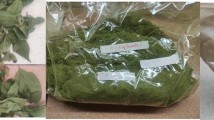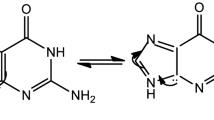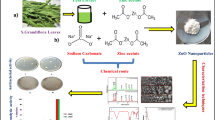Abstract
Novel five complexes of vanadium (V) with norfloxacin containing oxygen donor ligand in presence of different solvents containing nitrogen or oxygen donor ligand have been prepared as solid complexes [VO(Nor)2L]Cl3·nH2O, where L = aniline (An), dimethylformamide (DMF), pyridine (Py), o-tolidine (o-Tol), and triethylamine (Et3N). The isolated complexes have been characterized with physicochemical and spectroscopic techniques. In these complexes, norfloxacin acts as a bidentate ligand bound to the vanadium ion through the pyridone oxygen and one carboxylato oxygen. The stretching band of ν(C=O)pyridone at 1619 cm−1 of ligand shifts toward lower wavenumbers at 1519 cm−1 for DMF, at 1578 cm−1 for An, at 1574 cm−1 for Py, at 1574 cm−1 for o-Tol, and 1555 cm−1 for Et3N, which indicates the pyridone group bonding to the vanadium (V) ion. The lowest energy model structure of each complex has been proposed by using the density functional theory at the B3LYP/CEP-31G level of theory. The ligand and their metal complexes were also evaluated for their antibacterial activity against three Gram-positive—Staphylococcus aureus, Staphylococcus epidermidis, and Bacillus pumilus—and three Gram-negative —Pseudomonas aeruginosa, Escherichia coli, and Klebsiella pneumoniae—microorganisms.















Similar content being viewed by others
References
Vieira LMM, de Almeida MV, Lourenco MCS, Bezerra FAFM, Fontes APS. Synthesis and antitubercular activity of palladium and platinum complexes with fluoroquinolones. Eur J Med Chem. 2009;44:4107–11.
Appelbaum PC, Hunter PA. The fluoroquinolone antibacterials: past, present and future perspectives. Int J Antimicrob Agents. 2000;16:5–15.
Refat MS. Synthesis and characterization of norfloxacin-transition metal complexes (group 11, IB): spectroscopic, thermal, kinetic measurements and biological activity. Spectrochim Acta A. 2007;68:1393–405.
Gao F, Yang P, Xie J, Wang H. Synthesis, characterization and antibacterial activity of novel Fe(III), Co(II), and Zn(II) complexes with norfloxacin. J Inorg Biochem. 1995;60:61–7.
Turel I, Leban I, Bikovec N. Synthesis, characterization, and crystal structure of a copper(II) complex with quinolone family member (ciprofloxacin): bis(1)-cyclopropyl-6-fluoro-1,4-dihydro-4-oxo-7-piperazin-1ylquinoline-3-carboxylate) copper(II) chloride hexahydrate. J Inorg Biochem. 1994;56:273–82.
Turel I, Golic L, Bukovee P. Antibacterial tests of bismuth(III)–quinolone (ciprofloxacin, cf) compounds against Helicobacter pylori and some other bacteria. Crystal structure of (cfH2)2[Bi2Cl10] 4H2O. J Inorg Biochem. 1998;71:53–60.
Yang P, Li JB, Tian YN, Yu KB. Synthesis and crystal structure of rare earth complex with ciprofloxacin. Chin Chem Lett. 1999;10:879–80.
Wu G, Wang G, Fu X, Zhu L. Synthesis, crystal structure, stacking effect and antibacterial studies of a novel quaternary copper (ii) complex with quinolone. Molecules. 2003;8:287–96.
Turel I, Leban I, Klintschar G. Synthesis, crystal structure, and characterization of two metal-quinolone compounds. J Inorg Biochem. 1997;66(2):77–82.
Blažič B, Turel I, Bukovec N, Bukovec P, Lazarini F. Synthesis and structure of diaquadichlorobis 9-[(2-hydroxyethoxy)methyl]guanine copper(II). J Inorg Biochem. 1993;51:737–44.
Turel I, Leban I, Zupancic M, Bukovec P, Gruber K. An adduct of magnesium sulfate with a member of the quinolone family (ciprofloxacin). Acta Crystallogr Sect C Cryst Struct Commun. 1996;52:2443–5.
Chen ZF, Xiong RG, Zuo JL. X-ray crystal structures of Mg2+ and Ca2+ dimers of the antibacterial drugnorfloxacin. Dalton Trans. 2000;22:4013–4.
Al-Mustafa J. Magnesium, calcium and barium perchlorate complexes of ciprofloxacin and norfloxacin. Acta Chim Slov. 2002;49:457–66.
Ruiz M, Perello L, Cario JS, Ortiz R, Granda SG, Diaz MR, Canton E. Cinoxacin complexes with divalent metal ions. Spectroscopic characterization. Crystal structure of a new dinuclear Cd (II) complex having two chelate-bridging carboxylate groups. Antibacterial studies. J Inorg Biochem. 1998;69:231–9.
Shen LL, Pernet AG. Mechanism of inhibition of DNA gyrase by analogues of nalidixic acid: the target of the drugs is DNA. Proc Natl Acad Sci USA. 1985;82:307–11.
Shen LL, Kohlbrenner WE, Weigl D, Baranowski J. Mechanism of Quinolone inhibition of DNA gyrase. J Biol Chem. 1989;264:2973–8.
Shea ME, Hiasa H. Distinct effects of the UvrD helicase on topoisomerase quinolone-DNA ternary complexes. J Biol Chem. 2000;275:14649–58.
King DE, Malone R, Lilley SH. New classification and update on the quinolone antibiotics. Am Fam Physician. 2000;61:2741–8.
Drago RS. Physical methods in inorganic chemistry rein hold. London: Reinhold Publication; 1965.
Geary WJ. The use of conductivity measurements in organic solvents for the characterisation of coordination compounds. Coord Chem Rev. 1971;7:81–122.
Vogel AI. A text book of quantitative inorganic analysis. London: Longman; 1978.
Turel I, Leban I, Klintschar G. Crystal structure and characterization of the bismuth(III) compound with quinolone family member (ciprofloxacin). Antibacterial study. J Inorg Biochem. 1997;66:241–5.
Turel I, Golic L, Ramirez OLR. Crystal structure and characterization of a new copper(II)-ciprofloxacin (cf) complex [Cu(cf)(H2O)3]SO4·2H2O. Acta Chem. Slov. 1999;46(2):203–11.
Deacon GB, Phillips RJ. Relationships between the carbon-oxygen stretching frequencies of carboxylato complexes and the type of carboxylate coordination. Coord Chem Rev. 1980;33:227–50.
Sultana N, Arayne MS, Gul S, Shamim S. Sparfloxacin–metal complexes as antifungal agents—their synthesis, characterization and antimicrobial activities. J Mol Struct. 2010;975:285–91.
Sadeek SA, El-Shwiniy WH. Metal complexes of the fourth generation quinolone antimicrobial drug gatifloxacin: synthesis, structure and biological evaluation. J Mol Struct. 2010;977:243–53.
Sadeek SA. Synthesis, thermogravimetric analysis, infrared, electronic and mass spectra of Mn(II), Co(II) and Fe(III) norfloxacin complexes. J Mol Struct. 2005;753:1–12.
Sadeek SA, Refat SM, Hashem AH. Complexation and thermogravimetric investigation on tin(II) and tin(IV) with norfloxacin as antibacterial agent. J Coord Chem. 2006;59:759–75.
Refat MS, Sadeek SA, Teleb SM. Reactions of urea with Mo(VI), V(V) and Se(IV) oxides at high temperature. J. Arg. Chem. Soc. 2004;92(4–6):23–9.
Teleb SM. Spectral and thermal studies of saccharinato complexes. Anales des la Asociacion Quimica Argentina. 2004;92(4–6):31–3.
Sadeek SA, Teleb SM, Refat MS, El-Mosallamy MAF. Preparation, thermal and vibrational studies of [UO2(acac-o-phdn)(L)] (L = H2O, py, DMF and Et3N). J Coord Chem. 2005;58:1077–85.
Sadeek SA, El-Didamony AM, El-Shwiniy WH, Zordok WA. Uranium (VI) and zirconium (IV) of the second-generation quinolone antimicrobial drug norfloxacin: structure and biological activity. J. Arg. Chem. Soc. 2009;97:51–76.
Riley CM, Ross DL, vander Velde D, Takusagawa F. Characterization of the complexation of fluoroquinolone antimicrobials with metal ions by nuclear magnetic resonance spectroscopy. J Pharm Biom. Anal. 1993;11:49–59.
Muhammad I, Javed I, Shahid I, Nazia I. In vitro antibacterial studies of ciprofloxacin-imines and their complexes with Cu(II), Ni(II), Co(II), and Zn(II). Turk J Biol. 2007;31:67–72.
Macias BS, Martinez CM, Sańchez NA, Hurle AD. Aphysico-chemical study of the interaction of ciprofloxacin and ofloxacin with polivaientcations. Int J Pharm. 1994;106:229–35.
Rossmore HW. Nitrogen compounds. In: Block SS, editor. Disinfection, sterilization and preservation, 4th ed. Philadelphia: Lea and Febinger; 1991. p. 290.
Psomas G, Dendrinou-Samara C, Philippakopoulos P, Tangoulis V, Raptopoulou CP, Samaras H, Kessissoglou DP. CuII-herbicide complexes: structure and bioactivity. Inorg Chim Acta. 1998;272:24–32.
Dendrinou-Samara C, Psomas G, Raptopoulou CP, Kessissoglou DP. Copper(II) complexes with phenoxyalkanoic acids and nitrogen donor heterocyclic ligands: structure and bioactivity. J Inorg Biochem. 2001;83:7–16.
Russell AD. Principles of antimicrobial activity and resistance. In: Block SS, editor. Disinfection, sterilization and preservation, 4th ed. Philadelphia: Lea and Febinger; 1991. p. 27.
Stevens WJ, Krauss M, Bosch H, Jasien PG. Relativistic compact effective potentials and efficient, shared-exponent basis sets for the third-, fourth-, and fifth-row atoms. Can J Chem. 1992;70:612–30.
Frisch MJ, Trucks GW, Schlegel HB, Scuseria GE, Robb MA, Cheeseman JR, Zakrzewski VG, Montgomery JA, StratmannJr RE, Burant JC, Dapprich S, Millam JM, Daniels AD, Kudin KN, Strain MC, Farkas O, Tomasi J, Barone V, Cossi M, Cammi R, Mennucci B, Pomelli C, Adamo C, Clifford S, Ochterski J, Petersson GA, Ayala PY, Cui Q, Morokuma K, Malick DK, Rabuck AD, Raghavachari K, Foresman JB, Cioslowski J, Ortiz JV, Stefanov BB, Liu G, Liashenko A, Piskorz P, Komaromi I, Gomperts R, Martin RL, Fox DJ, Keith T, Al-Laham MA, Peng CY, Nanayakkara A, Gonzalez C, Challacombe M, Gill PMW, Johnson B, Chen W, Wong MW, Andres JL, Gonzalez C, Head-Gordon M, Replogle ES, Pople JA. Gaussian 98, Revision A.6. Pittsburgh: Gaussian, Inc.; 1998.
Kohn W, Sham LJ. Self-consistent equations including exchange and correlation effects. Phys Rev A. 1965;140:1133–8.
Becke AD. Density-functional exchange-energy approximation with correct asymptotic behavior. Phys Rev A. 1988;38:3098–100.
Lee C, Yang W, Parr RG. Development of the Colle-Salvetti correlation-energy formula into a functional of the electron density. Phys. Rev B. 1988;37:785–9.
Flurry RL Jr. Molecular orbital theory of bonding in organic molecules. New York: Marcel Dekker; 1968.
Drevenšek P, Zupančič T, Pihlar B, Jerala R, Kolitsch U, Plaper A, Turel I. Mixed-valence Cu(II)/Cu(I) complex of quinolone ciprofloxacin isolated by a hydrothermal reaction in the presence of l-histidine: comparison of biological activities of various copper–ciprofloxacin compounds. J Inorg Biochem. 2005;99:432–42.
Živec P, Perdih F, Turel I, Giester G, Psomas G. Different types of copper complexes with the quinolone antimicrobial drugs ofloxacin and norfloxacin: structure, DNA- and albumin-binding. J Inorg Biochem. 2012;117:35–47.
Turel I, Leban I, Gruber K, Bukovec N. Synthesis, crystal structure, and characterization of three novel compounds of the quinolone family member (norfloxacin). J Inorg Biochem. 1996;61:197–212.
Drevenšek P, Košmrlj J, Giester G, Skauge T, Sletten E, Sepčić K, Turel I. X-ray crystallographic, NMR and antimicrobial activity studies of magnesium complexes of fluoroquinolones—racemic ofloxacin and its S-form, levofloxacin. J Inorg Biochem. 2006;100:1755–63.
Tangoulis V, Psomas G, Denrrinou-Samara C, Raptopoulau CP, Terzis A, Kessissoglau DP. A two-dimensional manganese(II) carboxylato polymer. structure, magnetism, and EPR study. Inorg Chem. 1996;35:7655–60.
Huang D, Wang W, Zhng X, Chen C, Chen F, Liu Q, Liao D, Li L, Sun L. Synthesis, structural characterizations and magnetic properties of a series of mono-, di- and polynuclear manganese pyridinecarboxylate compounds. Eur J Inorg Chem. 2004;7:1454–64.
Armentano D, de-Munno G, Guerra F, Faus J, Lloret F, Julve M. 2,2′-Bipyrimidine- and 2,3-bis(2-pyridyl)pyrazine-containing manganese(II) compounds: structural and magnetic properties. Dalton Trans. 2003;24:4626–34.
McCann M, Casey MT, Devereux M, Curran M, Mckee V. Manganese(II) complexes of hexanedioic and heptanedioic acids: X-ray crystal structures of [Mn(O2C(CH2)4CO2(phen)2H2O] 7H2O and [Mn(phen)2(H2O)2][Mn(O2C(CH2)5CO2) [phen)2H2O](O2C(CH2)5CO2)12.5H2O. Polyhedron. 1997;16:2741–8.
Reynolds JG, Biggs WR. Application of size exclusion chromatography coupled with element-specific detection to the study of heavy crude oil and residua processing. Accts Chem Res. 1988;21:319–26.
Bu XR, Mintz EA. Synthesis and characterization of vanadyl complexes with unsymmetrical bis-schiff base ligands containing acis-N2O2 coordinate chromophore. Polyhedron. 1996;15:4585–91.
Mani V, Lloffman JT, Dimayuga VL, Dwight T, Carrano CJ. A comparison of vanadylacetylacetonate complexes of N2O heteroscorpionate ligands that vary systematically in donor set. Inorg Chim Acta. 2007;360:529–34.
Zborowski K, Grybos R, Proniewicz LM. Molecular structures of oxovanadium (IV) complexes with maltol and kojic acid: a quantum mechanical study. Inorg. Chem. Communications. 2005;8:76–8.
Mimoun H, Saussine L, Daire E, Postel M, Fischer J, Weiss R. Vanadium (V) peroxy complexes. New versatile biomimetic reagents for epoxidation of olefins and hydroxylation of alkanes and aromatic hydrocarbons. J Am Chem Soc. 1983;105:3101–10.
Comba P, Kuwata S, Linti G, Tarnai M, Wadepohl H. Synthesis and oxidation of vanadyl complexes containing bispidine ligands. Eur J Inorg Chem. 2007;5:657–64.
Amin SS, Cryer K, Zhang B, Dutta SK, Eaton SS, Anderson OP, Miller SM, Reul BA, Brichard SM, Crans DC. Chemistry and insulin-mimetic properties of bis(acetylacetonate)oxovanadium (IV) and derivatives. Inorg Chem. 2000;39:406–16.
Turel I, Golobic A, Klazar A, Pihlar B, Buglyo P, Tolis E, Rehder D, Sepcic K. Interactions of oxovanadium (IV) and the quinolone family member—ciprofloxacin. J Inorg Biochem. 2003;95:199–207.
Christofis P, Katsarou M, Papakyriakou A, Sanakis Y, Katsaros N, Pasomas G. Mononuclear metal complexes with piroxicam: synthesis, structure and biological activity. J Inorg Biochem. 2005;99:2197–210.
Salcedo R, Zaragoza IP, Martínez-Magadán JM, García-Cruz I. Electronic structure in different environments for vanadyl porphyrinate molecules present in crude oil. J. Mol. Struct. (Theochem). 2003;626:195–201.
Fleming I. Frontier orbitals and organic chemical reactions. London: Wiley; 1976.
Kurtaran R, Odabasoglu S, Azizoglu A, Kara H, Atakol O. Experimental and computational study on [2,6-bis(3,5-dimethyl-N-pyrazolyl)pyridine]-(dithiocyanato)mercury(II). Polyhedron. 2007;26:5069–74.
Author information
Authors and Affiliations
Corresponding author
Electronic supplementary material
Below is the link to the electronic supplementary material.
Rights and permissions
About this article
Cite this article
Zordok, W.A., Sadeek, S.A. Synthesis, spectroscopic, structure, thermal analyses, and biological activity evaluation of new norfloxacin vanadium (V) solvates (L) (L = An, DMF, Py, Et3N and o-Tol). J Therm Anal Calorim 128, 971–991 (2017). https://doi.org/10.1007/s10973-016-5979-4
Received:
Accepted:
Published:
Issue Date:
DOI: https://doi.org/10.1007/s10973-016-5979-4




